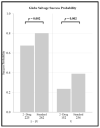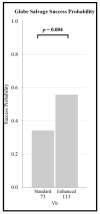Effect of Intravenous Chemotherapy Regimen on Globe Salvage Success Rates for Retinoblastoma Based on Disease Class-A Meta-Analysis
- PMID: 34066325
- PMCID: PMC8125212
- DOI: 10.3390/cancers13092216
Effect of Intravenous Chemotherapy Regimen on Globe Salvage Success Rates for Retinoblastoma Based on Disease Class-A Meta-Analysis
Abstract
To evaluate the relative efficacy of novel retinoblastoma treatments, eye classification-specific success rates for current standard-of-care intravenous chemotherapy regimens must be known. This meta-analysis included studies if: (1) patients received intravenous chemotherapy for retinoblastoma, (2) globe salvage data was reported, (3) only intravenous chemoreduction (with/without local consolidation) was used. The outcome measure was globe salvage success without need for salvage radiotherapy, subdivided by disease classification and chemotherapy regimen. Data from 27 studies (1483 eyes) were pooled. By Reese-Ellsworth classification, globe salvage rates were 85% (95%CI:73-92%) for Group I, 78% (95%CI:70-85%) for Group II, 68% (95%CI:56-78%) for Group III, 47% (95%CI:34-60%) for Group IV, and 35% (95%CI:26-45%) for Group V (Va: 35% [95%CI:21-54%]; Vb: 42% [95%CI:29-56%]; those without sub-classification: 31% [95%CI:19-47%]). By International Classification, globe salvage rates were 93% (95%CI:80-97%) for Group A, 83% (95%CI:73-89%) for Group B, 73% (95%CI:54-86%) for Group C, 40% (95%CI:31-51%) for Group D, and 19% (95%CI:5-50%) for Group E. Standard carboplatin-etoposide-vincristine out-performed two-drug regimens (odds ratio (OR) = 1.9 (95%CI:1.3-3.0) for Groups I-IV and OR = 2.1 (95%CI:1.3-3.4) for Group V; p = 0.002 for each). For eyes with diffuse vitreous seeds (Vb), an enhanced regimen out-performed standard chemotherapy (OR = 2.4 [95%CI:1.3-4.7]; p = 0.004). In conclusion, two-drug regimens were less effective for all eyes, whereas enhanced regimens were more effective for eyes with vitreous seeds. Novel therapies can now be compared to these baseline globe salvage rates.
Keywords: Reese–Ellsworth classification; globe salvage rates; international classification of retinoblastoma; intra-arterial chemotherapy; intravenous chemotherapy; intravitreal chemotherapy; radiotherapy; retinoblastoma.
Conflict of interest statement
A.B.D. and D.L.F. have an unrelated patent with Vanderbilt University Medical Center. A.B.D. receives research funding from an Alcon Research Institute Young Investigator Award and from Spectrum Pharmaceuticals, Inc. (now Acrotech Biopharma), neither of which are related to the work described herein. These funders had no role in the design of the study; in the collection, analyses, or interpretation of data; in the writing of the manuscript, or in the decision to publish the results. None of the other authors has any conflicts to report. All information in this manuscript is original and not published elsewhere.
Figures




References
Publication types
Grants and funding
LinkOut - more resources
Full Text Sources

